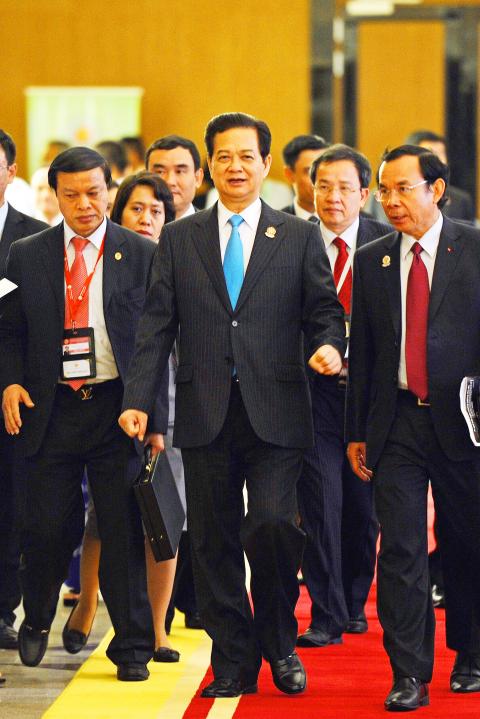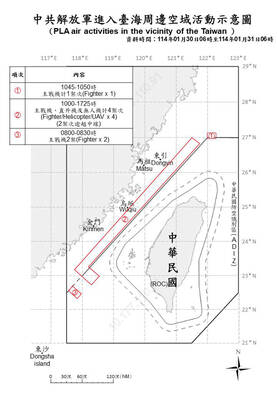Vietnam and the Philippines yesterday pushed for stronger action to confront China’s aggressive behavior in the South China Sea at the first regional summit hosted by Myanmar.
A showdown between Chinese and Vietnamese ships near the Paracel Islands (Xisha Islands, 西沙群島) — also claimed by Taiwan — has put a spotlight on long-standing and bitter maritime disputes.
Several members of the ASEAN bloc reject China’s claims to much of the South China Sea, saying parts of the sea are theirs, but few are willing to risk their political and economic relationship with the regional powerhouse.

Photo: AFP
A draft of the closing statement from the summit, obtained by The Associated Press, made no direct mention of China, and ASEAN foreign ministers who gathered on Saturday did little beyond expressing concern and calling for self-restraint.
However, Vietnam and the Philippines both made it clear they wanted more.
“China has brazenly moved its deep-water drilling rig escorted by over 80 armed and military vessels and many airplanes to the Vietnamese waters,” Vietnamese Prime Minister Nguyen Tan Dzung was quoted as saying in a draft speech.
The vessels “fired high-powered water cannons and rammed straight into the Vietnamese public-service and civil ships, causing damage to many ships and injuring many people on board.”
He asked that concerns about the South China Sea be included in ASEAN’s final statement.
The standoff between China and Vietnam started on May 1 when China moved a deep-sea oil rig into waters close to the Paracel Islands in what most analysts believe was an especially assertive move to help cement its claims of sovereignty over the area.
China insists it is doing nothing wrong.
Chinese Ministry of Foreign Affairs spokeswoman Hua Chunying (華春瑩) yesterday said that the issue should not concern ASEAN and that Beijing was opposed to “one or two countries’ attempts to use the South China Sea issue to harm the overall friendship and cooperation between China and ASEAN,” Xinhua news agency reported.
ASEAN leaders also discussed tensions on the Korean Peninsula, reiterating their commitment to a region “free of nuclear weapons and all other weapons of mass destruction,” according to the draft of the final statement.
They also discussed the need to effectively tackle threats such as cybercrime, human trafficking and climate change, as well as food and energy security, human rights issues and efforts to create an ASEAN economic community.
Earlier in the day, protesters staged one of Vietnam’s largest ever anti-China demonstrations over the oil-rig standoff.
About 1,000 people, from war veterans to students, waved banners saying: “China. don’t steal our oil” and “Silence is cowardly” — a dig at Hanoi’s handling of the dispute — and sang patriotic songs in a park opposite the Chinese embassy in Hanoi.
War veteran Dang Quang Thang, 74, said: “Our patience has limits. We are here to express the will of the Vietnamese people to defend our territory at all costs. We are ready to die to protect our nation.”
Hundreds of plainclothes and uniformed police set up barricades to prevent protesters approaching the Chinese embassy compound, but made no move to break up the rowdy demonstration, even though the regime normally tightly controls any public expression of discontent.
Protests also broke out in central Danang town and Ho Chi Minh City yesterday.

Taiwanese actress Barbie Hsu (徐熙媛) has died of pneumonia at the age of 48 while on a trip to Japan, where she contracted influenza during the Lunar New Year holiday, her sister confirmed today through an agent. "Our whole family came to Japan for a trip, and my dearest and most kindhearted sister Barbie Hsu died of influenza-induced pneumonia and unfortunately left us," Hsu's sister and talk show hostess Dee Hsu (徐熙娣) said. "I was grateful to be her sister in this life and that we got to care for and spend time with each other. I will always be grateful to

REMINDER: Of the 6.78 million doses of flu vaccine Taiwan purchased for this flu season, about 200,000 are still available, an official said, following Big S’ death As news broke of the death of Taiwanese actress and singer Barbie Hsu (徐熙媛), also known as Big S (大S), from severe flu complications, the Centers for Disease Control (CDC) and doctors yesterday urged people at high risk to get vaccinated and be alert to signs of severe illness. Hsu’s family yesterday confirmed that the actress died on a family holiday in Japan due to pneumonia during the Lunar New Year holiday. CDC Deputy Director-General Tseng Shu-hui (曾淑慧) told an impromptu news conference that hospital visits for flu-like illnesses from Jan. 19 to Jan. 25 reached 162,352 — the highest

TAIWAN DEFENSE: The initiative would involve integrating various systems in a fast-paced manner through the use of common software to obstruct a Chinese invasion The first tranche of the US Navy’s “Replicator” initiative aimed at obstructing a Chinese invasion of Taiwan would be ready by August, a US Naval Institute (USNI) News report on Tuesday said. The initiative is part of a larger defense strategy for Taiwan, and would involve launching thousands of uncrewed submarines, surface vessels and aerial vehicles around Taiwan to buy the nation and its partners time to assemble a response. The plan was first made public by the Washington Post in June last year, when it cited comments by US Indo-Pacific Commander Admiral Samuel Paparo on the sidelines of the Shangri-La Dialogue

Suspected Chinese spies posing as Taiwanese tourists have been arrested for allegedly taking photographs of Philippine Coast Guard ships, local media reported. The suspected spies stayed at a resort in Palawan, where from a secluded location they used their phones to record coast guard ships entering and leaving a base, Philippine TV network GMA said on Wednesday. Palawan is near the Spratly Islands (Nansha Islands, 南沙群島) and other disputed areas of the South China Sea, where tensions have been on the rise between China and the Philippines. The suspects allegedly also used drones without permission and installed cameras on coconut trees in the